- Retour accueil
- Vous êtes ici : Blog Chemistry in Ancient Egypt Ancient Egyptian God Nefertem with the Lotus Flower Emblem is depicting the horizontal cooling passage of the Great Pyramid of Khufu ©2021
Ancient Egyptian God Nefertem with the Lotus Flower Emblem is depicting the horizontal cooling passage of the Great Pyramid of Khufu ©2021
Publié par Bruno Coursol dans Chemistry in Ancient Egypt le 16/08/2021 à 18:57
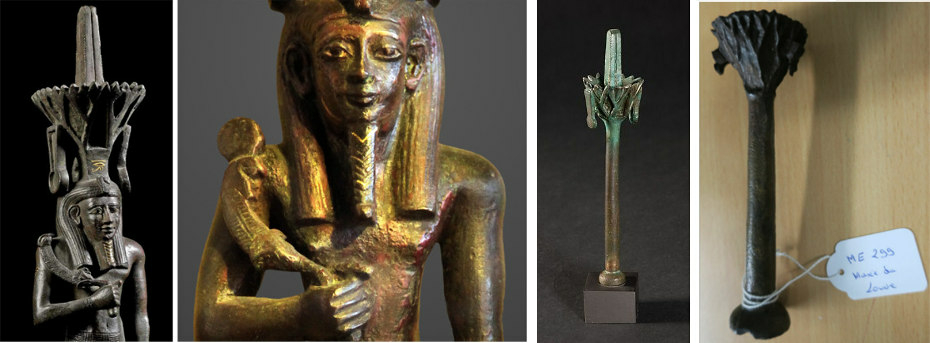
Ancient Egyptian God Nefertem (also Nefertum), depicted with a lotus flower on his head was actually representing the horizontal cooling passage of the Great Pyramid of Khufu at Giza. His emblems were the Khepesh Scimitar spanner wrench and a blooming lotus flower fog nozzle attached to a pressurized water resistant supplying copper pipe.
We've seen in previous posts that the Great Pyramid of Khufu at Giza was the culmination of a technological research program for sodium carbonate manufacturing, the purest mineral form of natron, the salt used by ancient Egyptians for the mummification process.
It looks like Sneferu was the main architect of this program and that he built 3 pyramids for it : the pyramid of Meidum, the Red pyramid and the Bent pyramid. And in my opinion, in this particular order. The pyramid of Meidum was a non functional mock-up of the functional Red Pyramid, but the strong ammonia smell of this pyramid tells us that they didn't control the temperature : they couldn't cool down the Solvay towers and the ammonia cycle couldn't be achieved like it is nowadays.
The Bent pyramid was the first attempt to deal with the temperature problem before the Great Pyramid was built (see previous posts for more details on the subject).

1/ God Nefertem / The academic point of view (Source : Wikipedia)
"Nefertem, possibly "beautiful one who closes" or "one who does not close", (also spelled Nefertum or Nefer-temu) was, in Egyptian mythology, originally a lotus flower at the creation of the world, who had arisen from the primal waters".
"Nefertem represented both the first sunlight and the delightful smell of the Egyptian blue lotus flower, having arisen from the primal waters within an Egyptian blue water-lily".
2/ God Nefertem / Bruno's point of view
The "either close or not close" reference
It is funny, because this academic vision of Nefertem, "either close or not close", could make sense after all.
"Close or not close" is not a bad definition for what was really representing Nefertem : the fog nozzle of the horizontal passage. This nozzle was eventually nothing else than a huge water tap that transformed pressurized water from the inclined well (the ascending passage) into a mist of microdroplets of liquid water. There was no valve though, just the fall of the piston inside the grand gallery of the Great Pyramid that pressurized the well.
The "delightful smell of the Egyptian blue lotus flower" reference, is most probably referring to the fog itself, though it wasn't a fragrant fog, but a very heavy cold fog.
The "Having arisen from the primal waters" reference , is most probably referring to the inclined well (the ascending passage of the Great Pyramid).
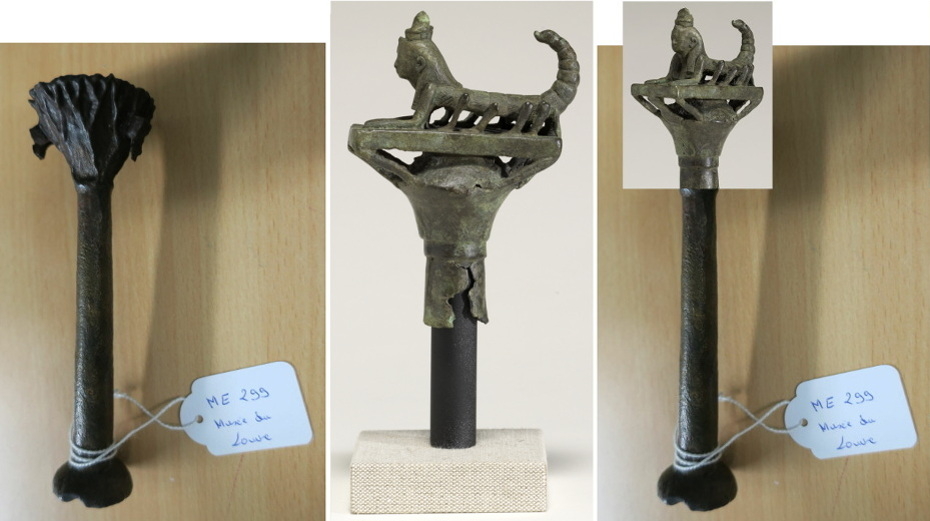
Left : Nefertem emblem from the Louvre Museum : inventory number ME299 © Musée du Louvre : https://collections.louvre.fr/ark:/53355/cl010337234. Center : Figure of Isis-Serget as Scorpion, ca. 663-346 BCE (Late Period) from the Walters Art Museum, Baltimore.
This artifact from the Walters Art Museum is one of the most important of all, because it is the best representation that I know of the cooling process that took place inside the Great Pyramid of Khufu.
The 8-legged scorpion with 2 pedipalps is another representation of the wooden beetle of the grand gallery
In previous posts, we've seen that the scarab amulets were representations of the wooden gantry that was operated inside the grand gallery by 8 crewmembers (+ 2 flying men who stayed behind its progression). The scarab was chosen because of the way the gantry was operated : the crewmembers were going backwards towards the bottom of the gallery. It is a good analogy, but the scarabs don't have 8 legs, they have 6.
The scorpions though, not only have 8 legs ; but they also have 2 pedipalps, and this is perfect to represent the 2 flying men. The scorpion also have a long tail with a telson at the end, (the back ; but projected towards to front of the animal), and I guess it is also perfect to echoes the backwards progression of the beetle scarab.
The missing crown of horns representing the pounding of the inclined well by the impactor
Originally the bust of the goddess Isis-Serget wore a crown of cow horns, similar to the ram horns of the Ptah-Sokar-Osiris figures.
From the Walters Art Museum : "The top of a scepter in the form of a papyrus column, surmounted by a pedestal supporting the figure of a scorpion with the bust of a woman, representing the goddess Isis-Serget. Originally she wore a crown of cow horns and sun-disk. The inscription on the shaft is badly damaged. The phrase: "Isis may give life" has been preserved."
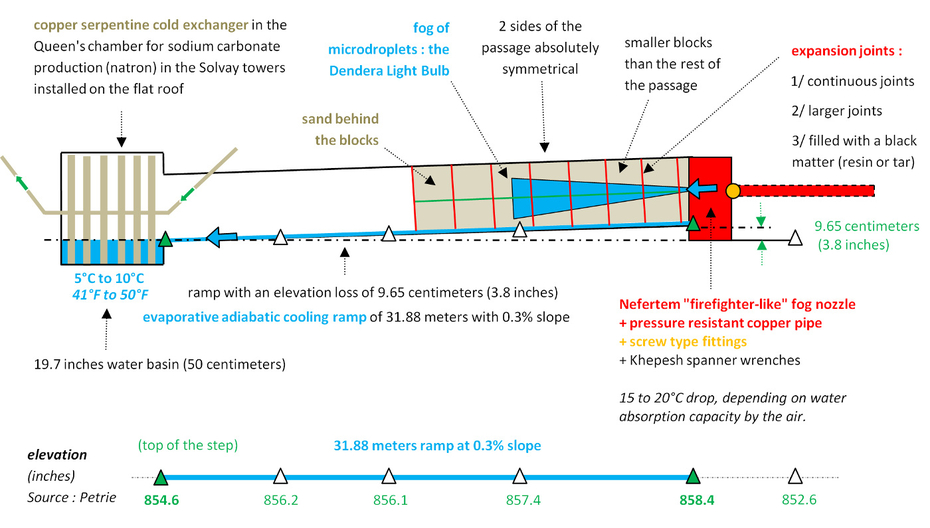
The horizontal passageway inside the Great Pyramid of Khufu at Giza was an evaporating cooling unit for the sodium carbonate (natron) Na2CO3 production by a soda-ash ammonia Solvay process. The key element of the passage was a multi-needle fog nozzle, very similar to modern firefighter nozzles. The nozzle transformed the pressurized water coming from the inclined well into a fog of liquid microdroplets that would evaporate in the passage and cool down the air between 5°C and 10°C.
Elevation data of the horizontal passage of the Great Pyramid (inches) : "The pyramids and temples of Gizeh", by Petrie, W. M. Flinders (William Matthew Flinders), Sir, 1853-1942. Page 66, "Passage to Queen's Chamber".

The Dendera Light Bulb is the microdroplets fog made of sprayed water that I am describing in my theory. It was produced to achieve evaporative cooling inside the horizontal passage of the Great Pyramid of Khufu at Giza, and it was designed to cool down chemical reactions for sodium carbonate manufacturing into Solvay-like towers (the Djed Pillars). This mineral is the purest mineral form of natron, the salt used for the mummification of the pharaohs.
Image on the left from the New York Public Library, and on the right from the Louvre Museum : Nefertem emblem inventory number N 5118 © Musée du Louvre / Christian Décamps : https://collections.louvre.fr/ark:/53355/cl010008518
On the Dendera Light reliefs, the fog is produced by the lotus flower, so I decided to focus my work on this, and I found out about the ancient Egyptian God Nefertem and his Lotus Flower main emblem. This Lotus Flower is obvious on the Nefertem representations, but it turns out there is more than just one emblem to decipher.
The Nefertem emblems at the Louvre Museum : the water supplying pipe and the lotus flower fog nozzle
I really didn't expect to find any archeological find representing the fog nozzle and the pipe that was connecting it to the inclined well, but I think this is exactly what we have here, on the above photograph of Nefertem copper alloy emblem artifact visible in the Louvre Museum. I presume the part getting upwards from the lotus flower is another representation of the fog of microdroplets.
I still don't know though what are representing the 2 pieces on the sides. They could be related to water, but they might be designed for dry air supply. This part of the global process will be the most difficult to decipher because contrary to pressurized water, air is so easy to move it doesn't require much equipment and leave very small amount of traces.
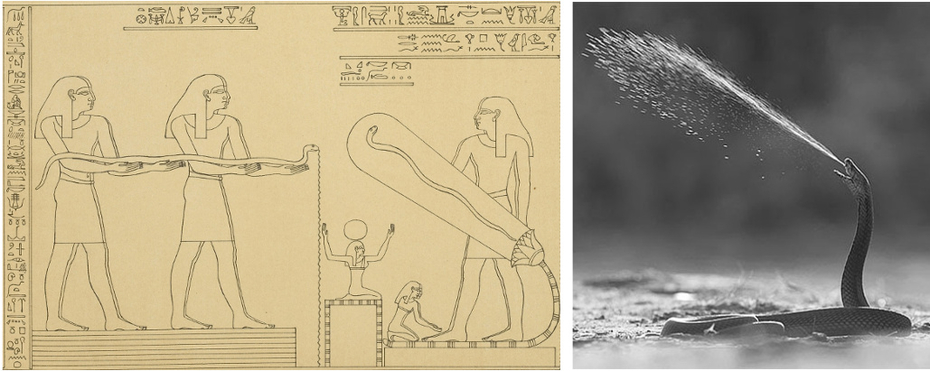
Dendera Light relief drawing on the left : please notice that what seems to be important here isn't the snake, but the spat venom of the snake. Also, you can see that the characters holding the snake are showing a double outline, the same way that the character holding (or offering) the Dendera Light does, on the right part of the drawing. The Dendera Light is produced by the snake, or as explained : by the venom of the snake. This particular relief is describing how was produced the microdroplets fog of sprayed water.
That drawing of one of the Dendera Light reliefs, is absolutely outstanding, because it is organized the same way we do today in every single science book : the theoretical part on one side and the practical part on the other side.
On the left side of the drawing, we can see that the key element is the spat venom of the snake and not the snake by itself : that represents the sprayed water ; and on the right side we can see the practical application of the concept inside the horizontal passage of the Great Pyramid : from the inclined well (the ascending passage), is the water pipe going to the fog nozzle and resulting in the microdroplets fog.
Please note that 1/ the angle of the Dendera Light Bulb is very similar to the angle of the typical venom spray of a spitting snake ; and 2/ the shape of the Light Bulb is very similar to the shape of the horizontal passage.

Dendera Light Bulb relief details, inside the Hathor temple in Egypt, showing this unique and outstanding double outline of the character offering the bulb : he was offering cold and he was cold himself.
The "double outline" of the character producing and offering the Dendera Light fog
This "double outline" isn't discussed at all by anybody, though it is the most important element of the Dendera reliefs. The fog is made of microdroplets of liquid water and it would evaporate itself, taking the necessary energy from the air. The result is the cooling down of the air. The character is offering cold, and he is cold himself.
The "double outline" of the offering fog character of the Dendera Light reliefs, shows the goose bumps. He was cold himself.
Actually, everything depends on the capacity of the air to absorb humidity. The example shown on the Carrier Diagram below, tells us that it was probably very easy to cool down the air next to 10°C, if the air started at a 10% humidity rate, and got to 90% at the end of the process.
But, I think they could cool down the air a lot more than that. Because at the entry of the pyramid, was certainly installed a liquid dehumidifier, working with a salt brine solution. The air at the beginning of the cooling process was probably close to 5% humidity or lower ; and the air inside the horizontal passage probably closer to 100%.
In my opinion, in regards to the extensive efforts to minimize the thermal stress on the first part of the horizontal passage, and the first part only, particularly the sand added behind the blocks and the large expansion joints, I wouldn't be surprised they got close to 5°C in the Queen's chamber (41°F).
The snake is representing the copper pipe and the fog nozzle of the horizontal passage
In previous posts, I have suggested 2 possibilities for the nature of the fog nozzle that ancient Egyptians could have chosen to produce the microdroplets fog into the horizontal passage of the Great Pyramid, using the inclined well pressurized water : a spiral nozzle and an external needle. But I think they used another option.
We have already seen that the snake was the symbol of the microdroplets fog production, because of the way that the snake is projecting its venom when protecting itself.
So, if they would have wanted to depict that fog nozzle, it would have been associated with the snake.
And that is precisely what they did.
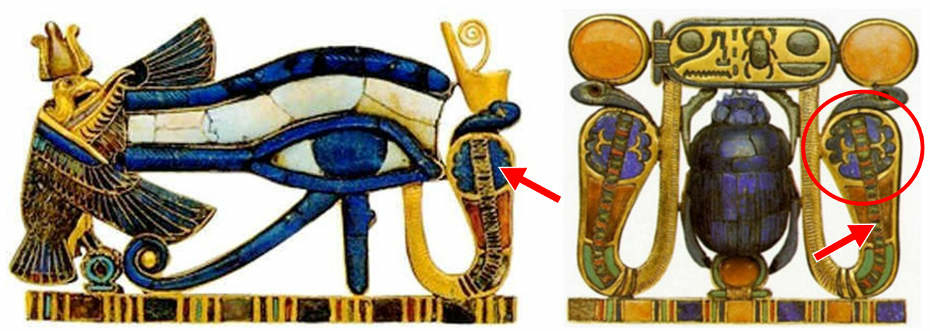
On these pictures of the Eye of Horus and scarab, are highlighted the fog nozzle under the snake's head, with the perfect circle shape, the blue color, and the segmented water pipe leading to it.
The fog nozzle of the Great Pyramid of Khufu had numerous teeth or sharper needles
On most snake representations, particularly when associated with the Eye of Horus, we can find a perfect circular shape just under its head, nearly every time painted in vivid blue, obviously the color of water. On many of these representations we can see that this circle is implemented with 6 needles pointing towards the center of the circle and most of the time there is an additional set of curved needles in the center of the circular shape (picture above, on the right).
Most of the time, the needles aren't very sharp, but occasionally (like on the left photograph, below), they really are ; and that tells us that these needles were functional and not pure artistic decoration.
That element is the fog nozzle of the Great Pyramid and the lotus flower of the Dendera Light Bulb reliefs.
There is just the head of the snake
If you look attentively, you can see that the "snake" isn't really actually one : it is just a pipe that ends with a perfect non-biological circular shape ; and on top of this, is added the head of a snake. But only this head look alive. There is nothing "biological" with the rest. That "snake look-alike" element is a perfect example of the sophistication of ancient Egyptian culture and a perfect example of our modern lack of examination of their work.
We see a snake because we want to. In reality, there is just its head, and we forgot to really look at the rest.
Take the head of the snake out of the picture, and nobody will ever see a snake anymore.
The crying / tears reference (1) : The Eye of Horus
Please note that the tail of the snake in this representation of the Eye of Horus is connected to the corner of the eye, where tears are coming from. Those tears are supplying the fog nozzle of the snake.
The crying / tears reference (2) : Nefertem
Nefertem is also often associated with the idea of crying and tears. I just couldn't find yet a "solid" reference to the explanation of this particular point, from a scholar point of view, but tears (water) would be obviously right in the context of supplying the fog nozzle with liquid water.

On the Dendera Light Bulb reliefs, the fog nozzle of the horizontal passage of the Great Pyramid of Khufu, is represented by the lotus flower, because of the appearance of its many and pointy petals that looked like the fog nozzle teeth or needles. Images in the center : various modern firefighter fog nozzles.
The modern firefighter-like design of the Great Pyramid fog nozzle
It looks like that the fog nozzle of the Great Pyramid of Khufu, was amazingly very similar to modern firefighter fog nozzles. These nozzles are designed to deal with a great amount of water : they are high capacity nozzles. It is hard to evaluate the amount of water that was injected in a matter of seconds into the horizontal passage of the Great Pyramid, but it could be around 500 liters, maybe every 15 to 20 minutes without ever stopping, for days, weeks, maybe even months.
It is also hard to say if the very sharp shape of the needles we can see in some paintings or reliefs of the fog nozzle depicted by ancient Egyptians, has to be taken literally or not.
The modern firefighter fog nozzle teeth aren't that sharp, but they don't have to produce microdroplets either. Their fog is not designed to immediately evaporate and create cold. So, maybe the needles of the pyramid's fog nozzle were really that sharp and pointy.
The Khepesh Scimitars of the Nefertem amulets were spanner wrenches for copper fittings
According to scholars, "ancient Egyptian God Nefertem (also Nefertum, or Nefertemu) was the god of the lotus blossom who emerged from the primeval waters at the beginning of time". That would explains the huge lotus blossom that Nefertem amulets displayed on their heads.
But most of the time, Nefertem is also having a Khepesh-Scimitar on the right hand, that is described as a warfare blade with sharpened edges, even if many examples have dull edges that apparently were never intended to be sharp.
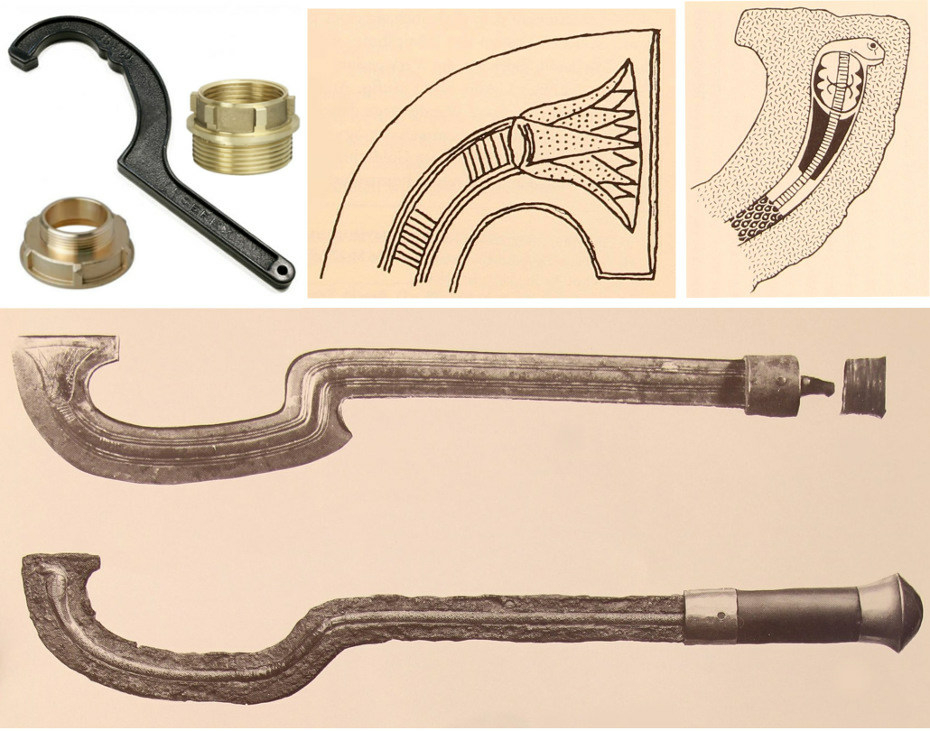
Top left photograph above : a modern spanner wrench designed to connect or disconnect metal fittings. The tooth at the end of the curved part of the tool is designed to engage onto the protuberances of the fitting. Other pictures are ancient Egyptians Khepesh Scimitars (exact dating is unknown to me).
According to scholars, again, "it may therefore be possible that some Khepeshes found in high-status graves were ceremonial variants". But in my opinion, the idea that the reason why some Khepeshes weren't sharp at all, would be because they would have been for ceremonial use, couldn't be more wrong. Even today, the ceremonial Japanese katanas are maybe the most sharp of all katanas precisely because they are for ceremonial use. They are the best and the most expensive ones. The only katanas or any other kind of sword, that would be with dull edges, are the ones for kids to play, and they would be in plastic or wood.

Ancient Egyptians were using spanner wrenches (and screw fittings ?)
My interpretation of the Khepesh hold by Nefertem is radically different. I keep saying that pressurized water was directed towards the fog nozzle of the horizontal cooling passage of the Great Pyramid, and for that to be possible, pressure resistant pipes were needed, and that is exactly what is depicted in the Nefertem emblem.
But there is more, because to connect the pipe to the fog nozzle, or pipe pieces to each other, they would certainly have to use fittings. And as a former winemaker, I know one thing for sure about pipes and fittings : when you want to connect or disconnect these elements, you cannot do anything without a spanner wrench (maybe not in the US or in Canada where screw fittings are very rare, but in France, at least).
The Khepesh that Nefertem is holding isn't for warfare, it is a spanner wrench.
On certain representations of Nefertem, like E 10665 from the Louvre Museum (photograph above), we can also see on top of the Khepesh, a circular form in direct contact with the tool (though apparently not to scale). Could that round form be the copper fittings ?
The higher position of the tooth could indicate that the hook system was different from modern screw fittings
We can see on the ancient Egyptian Khepeshes that the tooth is placed higher in relation to the handle axis than on the modern spanner wrenches and it could mean that the hook system was different : on the modern tool, the tooth is designed to hook to an external piece of the screw fitting, but it is possible that on the ancient Khepeshes, there were sockets carved inside the fittings instead or that it wasn't at all screw fittings.

Photographs above : E10665 from the Louvre Museum (left).
What is remarkable with these Khepeshes, is that they can probably indicate what was the pipe diameter they were designed for, and we can find out if different diameters were used or not. We also know they were probably using screw-type fittings.
Nefertem is the personification of the horizontal passage fog nozzle of the Great Pyramid.
To be convinced of this, please note that on these pictures above of 2 different Khepeshes, one is engraved with the lotus flower, while a snake appears on the other one, showing the 6 teeth / needles.
Both elements, the circular shape of the snake and the lotus flower, are representing the same thing : the fog nozzle.
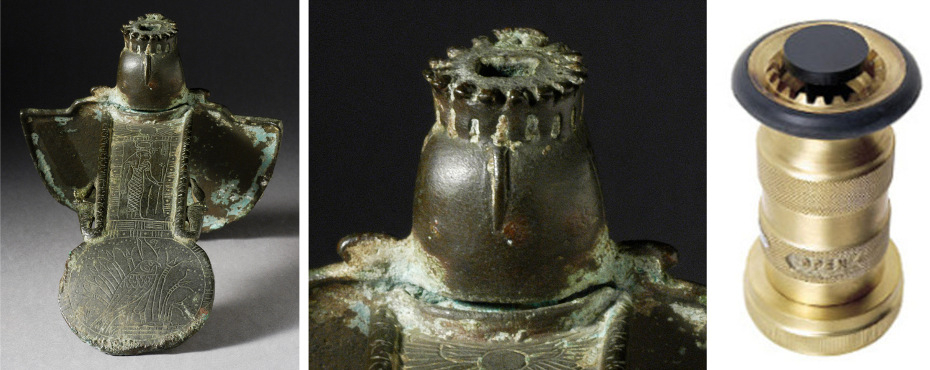
Image from the LACMA : Cultic Aegis and Menat with a Goddess Head. Egypt, 19th and 20th Dynasties (1315 - 1081 BCE). Bronze, 4 1/4 × 4 1/2 × 5 5/8 in. (10.8 × 11.43 × 14.29 cm). The Phil Berg Collection at the Los Angeles County Museum of Art. Image on the right is a modern high pressure firefighter fog nozzle.
The fog nozzle at the LACMA, Los Angeles
Maybe the artifact shown on the above photograph from the LACMA at Los Angeles, is the closest we can get to the real design of the fog nozzle of the cooling passage. It is worth noting the presence of the little vertical notch in the middle of the nozzle that would have been used, most probably, by the Khepesh spanner wrench to screw or unscrew it to its support bracket.
The teeth of the nozzle are obviously not on the inside of the artifact, but we have to keep in mind that ancient Egyptians acted like they wanted to show everything of their technical feats, but at the same time, like they wanted to hide everything.
If I am right, they did exactly that on this artifact : everything is here, but it is misplaced : the top part of the nozzle (with the teeth) shouldn't be on top of the artifact, but inside it (inside the base). Besides, it looks like both parts aren't fixed together by any metal part (but I may be wrong on this point), but instead they kind of look they got fixed due to alteration over time (the grayish material).
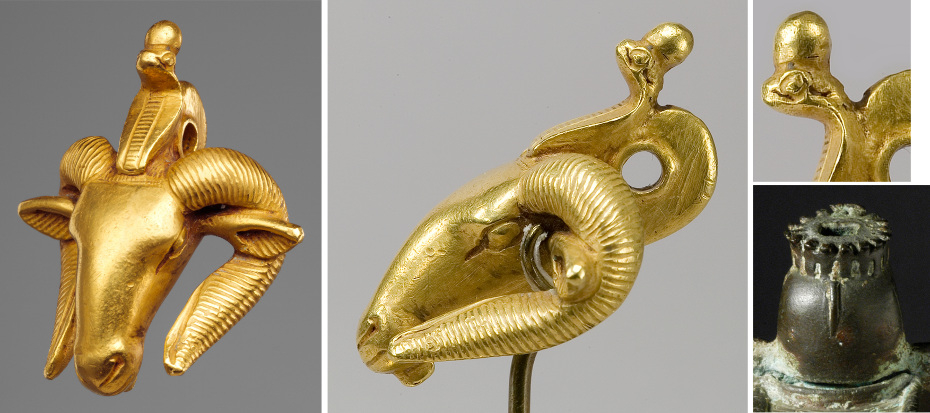
Ram's-head Amuletca, 712–664 B.C from the Metropolitan Museum of Art, New-York
The 3D representation of the fog nozzle
Another amazing artifact from the MET, is this golden ram's head that is another wonderful representation of the making of the fog of microdroplets. The ram's head horns echoes the pressurization of the inclined well (the ascending passage) by the fall of the impactor, and the snake echoes the use of its pressurized water. Instead of representing the fog nozzle as usual, with the circular shape and the 6 teeth or needles, which is nothing else than a 2 dimensions cross section of the nozzle, this time they represented the whole thing in 3D, in the exact same dome shape that we have on the previous artifact from the LACMA (if we place the crown with its teeth, back into its base).
Could the Sun Discs represent the fog nozzle ?
When I first saw this LACMA artifact, it was the front view photograph, and I thought that there was another Sun Disc on top of the head of the snake. Obviously it is not, but I'm wondering if it could be the explanation for the Sun Discs. What if they don't represent a disc at all, but a 3D representation of a golden fog nozzle ?
The suspension loop of the ram's-head amulet
Another remark has to be made, and it concerns the loop at the back of the artifact:
From the MET : "This amulet was probably made for a necklace worn by one of the Kushite kings. Representations show these pharaohs wearing a ram's-head amulet tied around the neck on a thick cord, the ends of which fall forward over the shoulders. Sometimes a smaller ram's head is attached to each end".
In my opinion, the loop of this particular amulet is way too massive to be nothing else than just a suspension loop for an amulet. I think it represents the attachment loop that was installed onto the real wooden cradle float and that would be connected to the main central rope of the gallery.

All the posts on the sodium carbonate and sodium bicarbonate manufacturing by the Solvay process, and its cooling in the Great Pyramid of Khufu : click here or on the "LE BLOG" button
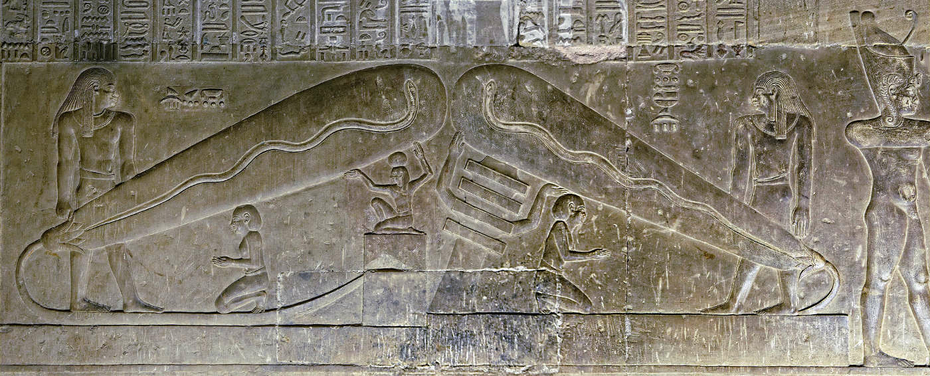
The Dendera Light Bulbs : the reliefs at the Hathor temple are describing every part of the theory, from the fog of microdroplets, to the cooling process of chemical manufacturing.
The Dendera Light is the microdroplets fog of the theory.
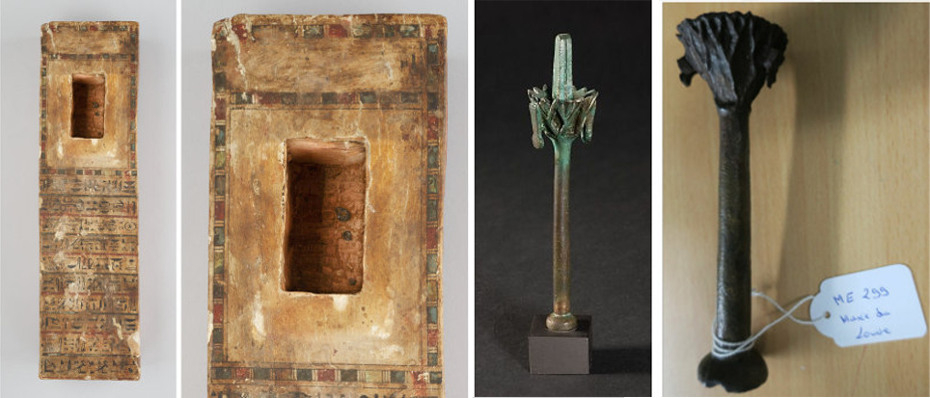
The wooden base of the Ptah-Sokar-Osiris figures : the moving caisson / impactor of the grand gallery
The Nefertem amulets : the fog nozzle of the horizontal cooling passage
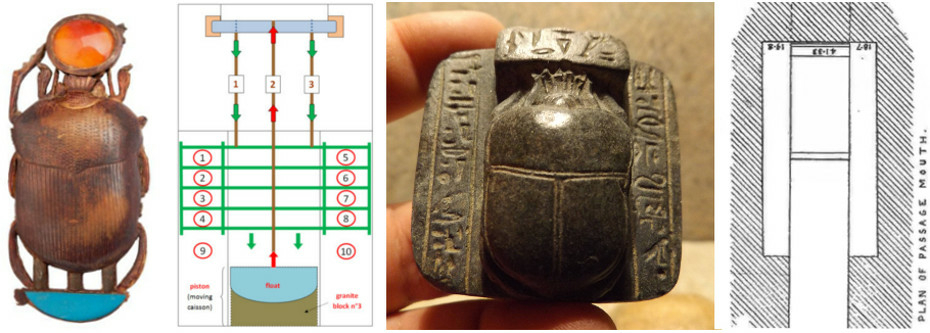
The Scarab Amulets : they are representations of the wooden gantry that was giving life to the Great Pyramid
The Nefertem amulets : the fog nozzle of the horizontal cooling passage
The Ptah-Sokar-Osiris figures : the moving caisson / impactor of the grand gallery
The Great Pyramid of Khufu at Giza
The sarcophagus : a bio-sand filter for the production of drinking water
The horizontal passage : an evaporative cooling unit
The grand gallery : the heart of the operating cycle of the pyramid, with the wooden scarab
The shut-down of the pyramid : the grotto and the draining of the inclined well
The pyramids of Sneferu
Sneferu : the revolutionary quest for immortality
The Red Pyramid : the limestone kiln and the pure sodium carbonate (natron) production by the Solvay process
The Bent Pyramid : the chemical sand filter and the last trials before the Great Pyramid
The Disc of Sabu : a counterflow chemical reaction perforated plate used in Solvay towers
Abstract (english) : "The Khufu's Great Pyramid Air Processing Unit"
Poster un commentaire
